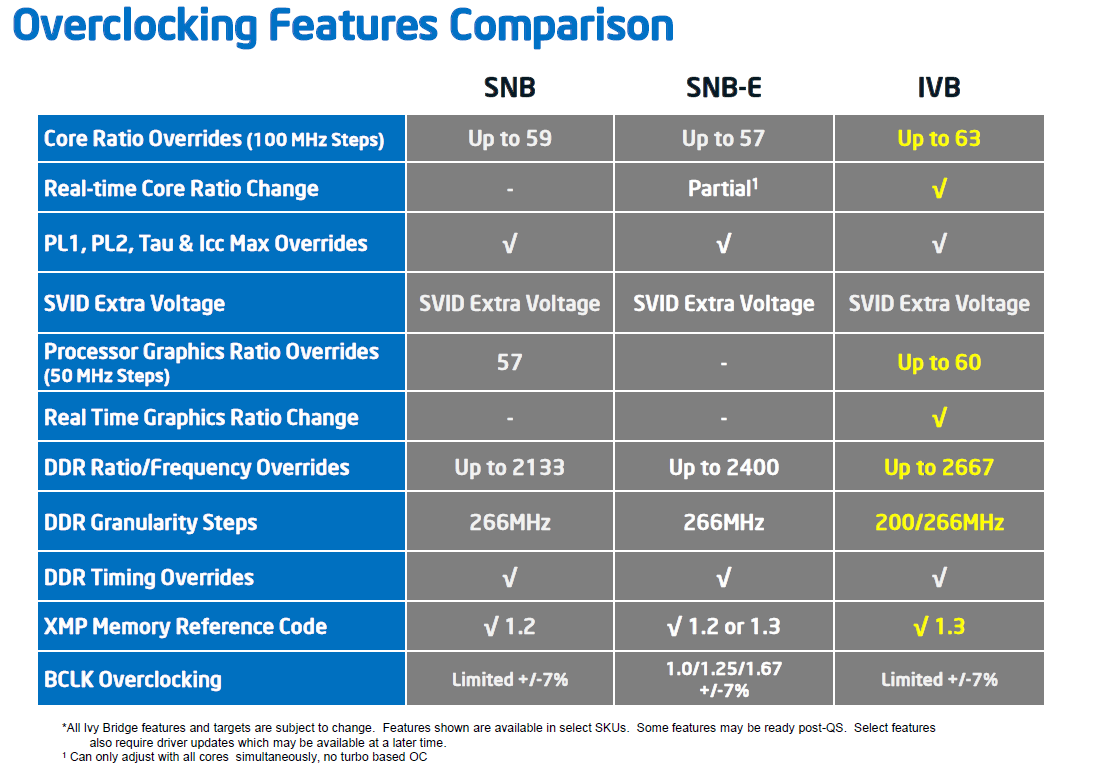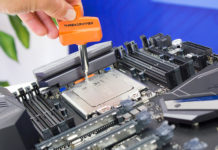Performance optimizations and lower power consumption
Ivy Bridge won’t be any regular Tick from Intel, where they simply has just shrunk the architecture to a new manufacturing technology. This time Intel has chosen to call it a Tick+, part of the reason for this is the new transistor, but also that they have done many changes i the processor itself – the biggest is the graphics portion.
Intel’s aggressive Tick-Tock schedule has one disadvantage. It’s a difficult task to be able to include all the things they would like every year. Some things just has to wait to next year, or simply be removed. Intel took a big risk with Sandy Bridge because they tried to learn a lot at once. It was mostly a new architecture, and they aimed very high with a new graphics architecture that they also chose to integrate on the same piece of silicon. Intel had planned for many things on Sandy Bridge but there just wasn’t enough time, and those is now emerging in Ivy Bridge. That’s why Ivy Bridge overall will have higher performance than what’s normal when shrinking a processor to a new manufacuring technology.
Performance optimizations and Turbo Boost
The processor cores is almost identical compared to before, but many small changes hides beneath the surface, and the result of this is many small improvements. Inte has optimized the performance when one thread is used, they have achieved this by rearranging in the internal structure of the multi-threading technology Hyper-threading. What this mean is when only one core is needed to work with one instead of two threads, more resources will be available in comparison to Sandy Bridge. The bottom line is that this should lead to higher performance when only one thread is used.
They are also supposed to have doubled the throughput of the processors floating point/integer dividers, but the biggest difference will most of all be seen in heavy floating point calculations which is more common in the server market than the consumer market. The performance increase at the same frequencies isn’t huge and sometimes even non existing. But the applications that benefit from the optimizations in the architecture should get an increase of around 4 to 6 percent at the same clock frequency as Sandy Bridge. The big difference shouldn’t lie here though, but instead their Turbo Boost technology should be more effective than ever before.
It’s interesting that the Core i7-3770K that replaces the Core i7-2700K has the exact same specifications seen to the cores, Hyper-threading, clock frequencies and cache memory. The thing that really stands out with the new Core i7-3770K though, is the new HD 4000 graphics. Despite this the latter should have an increased performance of up to 10 percent, partly thanks to the optimizations in the architecture that we mentioned above, but for the most part due to Turbo Boost working much more frequently than before. All the Ivy Bridge processors should very rarely work at it’s base frequency, but almost constantly be able to work in it’s turbo frequency.
Improved memory controller with Power Gating
Power Gating is a technology that Intel introduced with their Nehalem architecture, it works for rather than lowering the frequency and the current in a certain part of the processor, they simply turn it off. What they do in theory is to add a loop of transistors surrounding the part you want to be able to turn off, to simply cut off the supply of power.
Sandy Bridge introduced Power Gating in pretty much every part of the processor, except the memory controller – in Ivy Bridge this changes. This means that it’s possible to shut down pretty much every part of the processor completely which in turn will lead to increased power saving, particularly during lower loads or in idle.
 2 667 MHz is a missprint, the real value is up to 2 800 MHz
2 667 MHz is a missprint, the real value is up to 2 800 MHz
Apart from adding Power Gating to the memory controller, Intel has improved the memory controller in another way. Intel has increased the standard frequency as they officially promised is going to work according to their specifications, from 1 333 MHz to 1 600 MHz. When we look at the overclocking there’s much more headroom than before. Sandy Bridge only supported up to 2 133 MHz, plus the small bit that you could touch the BLCK frequency. Now there’s support for overclocking of up to 2 800 MHz and you can also overclock the memories in steps of 200 MHz. To comply with JEDEC’s standards they have kept the possibility to increase the memory frequency in increments of 266 MHz.
The thing that will affect mostly laptops is the new support for DDR3L. Regular DDR3 memories is specified to 1,5V, while DDR3L is the exact same standard except for 1,35V. What this means is that OEM manufacturers will be able to equip laptops with more power efficient memory, to achieve a lower power consumption and therefore longer battery life. DDR3L consume around 15 percent less power than DDR3, running at the same clock frequency.



















Great review guys, i would really love to see you do much more of them =]
A really great review, good job. Waiting to get my hands on it… but don’t know when it will arrive in Brazil
Glad you liked it
We hope the new translators will have time for more of these.
You used DDR3-1333 for AMD APU when it’s known that those processors need faster RAM to reach top performance, unlike Intel’s which don’t scale up accordingly. As it is, this is a very Intel-biased review.
[quote name=”Taki R”]You used DDR3-1333 for AMD APU when it’s known that those processors need faster RAM to reach top performance, unlike Intel’s which don’t scale up accordingly. As it is, this is a very Intel-biased review.[/quote]If you’re talking about CPU performance, the difference is very much negligible. I can agree however if we’re talking GPU-performance, where may I add, even Ivy Bridge HD 4000 benefits from higher RAM-clocks as well so it’s pretty much apples-to-apples in that regard. We will be revising our testing methodology during the summer, so we’ll be taking all of these things into close consideration… Läs hela »
It seem Intel will beat AMD more with this line of new generation processor. It is faster and consume less power than sandy bridge and trinity. Core per core / clock per clock basis.
I really like to know though the performance and efficiency compare to AMD trinity.
É realmente incrível todo esse progresso/evolução da INTEL.
BRASIL – CRATO – CEARÁ
É realmente incrível todo esse progresso/evolução da INTEL.
BRASIL – CRATO – CEARÁ
What happens if I put a 125w TDP CPU on a 95w motherboard? If I have a quad-core CPU and disable 2 cores will my CPU fit in the 95w TDP?